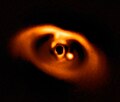| Observation data Epoch J2000 Equinox J2000 | |
|---|---|
| Constellation | Octans [1] |
| Right ascension | 19h 20m 54.37612s [2] |
| Declination | −82° 33′ 16.1679″ [2] |
| Apparent magnitude (V) | 12.69 [3] |
| Characteristics | |
| Evolutionary stage | Main sequence |
| Spectral type | M3.5V [4] |
| Apparent magnitude (V) | 12.69±0.03 [3] |
| Apparent magnitude (G) | 11.413±0.003 [2] |
| Apparent magnitude (J) | 8.555±0.030 [3] |
| Apparent magnitude (H) | 8.004±0.038 [3] |
| Apparent magnitude (K) | 7.686±0.042 [3] |
| Astrometry | |
| Radial velocity (Rv) | −10.59±0.24 [2] km/s |
| Proper motion (μ) | RA: +342.300 mas/yr [2] Dec.: −1230.297 mas/yr [2] |
| Parallax (π) | 80.1134±0.0206 mas [2] |
| Distance | 40.71 ± 0.01 ly (12.482 ± 0.003 pc) |
| Details [3] | |
| Mass | 0.274±0.015 M☉ |
| Radius | 0.2789±0.0014 [4] R☉ |
| Luminosity (bolometric) | 0.00862±0.00039 L☉ |
| Surface gravity (log g) | 4.964±0.046 cgs |
| Temperature | 3289±83 K |
| Rotation | 79.317 d |
| Other designations | |
| GJ 4102, L 22-69, LFT 1458, LHS 475, LTT 7606, NLTT 47504, PM J19209-8233, TOI-910, TIC 369327947, 2MASS J19205439-8233170 [5] | |
| Database references | |
| SIMBAD | data |
| Exoplanet Archive | data |
LHS 475 is a red dwarf star located 40.7 light-years (12.5 parsecs ) away from the Solar System in the constellation of Octans. It hosts one known exoplanet. [6] [7]




